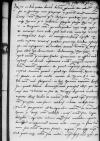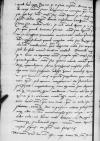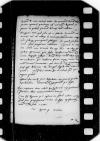Lectis ⌊⌋ Reverendissimae Paternitatis Vestrae obstupui, quod ea, quae scripsit mihi Reverendissima Paternitas Vestra, audierim ⌊⌋ Reverendissimae Paternitati a ⌊reginali maiestate⌋, quandoquidem non mihi ipsi et universae huic aulae, sed toti orbi nota est virtus et integritas eius. Et novissime dominus ⌊Oczieski⌋, ex aula ⌊caesaris⌋ veniens, publico praeconio hocidem testatus est me instigante et laudesm, amorem honoremque eius, in quo illuc est, decantavit declaravtique Reverendissimam Dominationem Vestram apud omnes principes ⌊Italiae⌋, ⌊Germaniae⌋ ac officiales aulae caesaris ac deinde inferiores omnes magnum nomen haberi, amorem ingentem et, quod imprimis scribere volui, caesaris summam gratiam. Quod ego vehementer Reverendissimae Dominationi Vestrae faveo et, ubi incidit mentio de Reverendissima Dominatione Vestra, incidit autem nunc frequenter in hoc episcoporum nostrorum decessu, quod dicant decrevisse hic superinscribed⌈hichic superinscribed⌉ iam prorsus illos, qui sacras eas tiaras in sua et ⌊regis⌋ dignitate tenebant, repetere illius laudes et virtutem soleo, quod videlicet principis nostri ⌊Prussia⌋ non fuerit talibus orbata ac destituta.
Proinde properavi ad ⌊reginalem maiestatem⌋ et ⌊⌋ Vestrae Reverendissimae Paternitatis eius maiestati reddidi. ⌊⌋ ⌊maiestas sua⌋ legit diligenter, ego vero vultum maiestatis suae metiebam, quem benignum et exporrectum revera vidi. Cumque in fine ⌊⌋ ⌊sua maiestas⌋ versata fuerit, rogavi pro exp responso, ad quod mihi maiestas sua respondit responso opus non esse, eo  BCz, 1597, p. 1172 quod litterae ipsae Reverendisimae Paternitatis Vestrae sint responsivae. At tum ego deinde ursi ⌊maiestatem suam⌋ diligentius et recensui, quam turbato sit ex his ⌊⌋ maiestatis suae animo Reverendissimae Paternitatis Vestrae. ⌊Eius maiestas⌋, praesente ibidem magnifico domino ⌊castellano Sandomiriensi⌋ magistro curiae suae, respondit mihi se nihil aliud Reverendissimae Paterniti Vestrae ⌊⌋, quam quod hortata fuerit maiestas sua Reverendissimam Paternitatem Vestram, ut se in officio senatorio contineret veluti primas ⌊illius terrae⌋, expostulans, quod negotia maiestatis suae regiae istuc alio modo tractarentur, quam dignitas maiestatis suae requirit. Sed de fide ceterum verbum nullum.
BCz, 1597, p. 1172 quod litterae ipsae Reverendisimae Paternitatis Vestrae sint responsivae. At tum ego deinde ursi ⌊maiestatem suam⌋ diligentius et recensui, quam turbato sit ex his ⌊⌋ maiestatis suae animo Reverendissimae Paternitatis Vestrae. ⌊Eius maiestas⌋, praesente ibidem magnifico domino ⌊castellano Sandomiriensi⌋ magistro curiae suae, respondit mihi se nihil aliud Reverendissimae Paterniti Vestrae ⌊⌋, quam quod hortata fuerit maiestas sua Reverendissimam Paternitatem Vestram, ut se in officio senatorio contineret veluti primas ⌊illius terrae⌋, expostulans, quod negotia maiestatis suae regiae istuc alio modo tractarentur, quam dignitas maiestatis suae requirit. Sed de fide ceterum verbum nullum.
Proinde rogo, Reverendissima Paternitas Vestra bono et aequiore animo ⌊⌋ ipsa ⌊maiestatis suae⌋ ferat, quandoquidem maiestatis suae optime novit morem, quod, quandoque excandescens, sacra prophanis miscere solet. Ego vero non suspicor adesse huiusmodi aemulos Reverendissimae Paternitati Vestrae, qui honorem eius <h>arpa<gan>nt(er) sugillent, quae omnibus non episcopum, sed virum(?) integerrimum et familiarem se praestat anxietatemque eam ex animo suo deponat eaque iniquitati temporum condonet. Nam ubi hic esset Reverendissima Paternitas Vestra, cerneret mutata superinscribed⌈tata superinscribed⌉ esse omnia et aliam faciem rerum omnium, quam tum erat, quando in aula ista versabatur, omniaque fere a pristino nitore prostituta atque adeo in aliam metamorphorsim versa, ut iam taedet aula, cui dicere vale decrevi, in ⌊regnum⌋ veniens vitamque proletariam sequi, Vestram vero Reverendissiam Paternitatem visere saepius, eo genere vitae fatigatus.
Novarum rerum hic nihil est, nisi sacra ⌊regalitas senior⌋  BCz, 1597, p. 1173 ex gratia Dei iam rectius valet et serenissimus dominus ⌊rex iunior⌋, optimus princeps, ad venationes bisontum se parat. In quibus summas delicias habere videtur.
BCz, 1597, p. 1173 ex gratia Dei iam rectius valet et serenissimus dominus ⌊rex iunior⌋, optimus princeps, ad venationes bisontum se parat. In quibus summas delicias habere videtur.
⌊Hungaria⌋ vero ipsa sola est in fabula hominum, metuimus enim, ne nobis et universae Christianitati negotium sibique praecipitum facessit, et quod sit futurum, aestas proxima indicabit. ⌊Caesarea et catholica maiestas⌋ cum serenissimo ⌊rege Romanorum⌋ et aliis principibus ⌊Germaniae⌋ pro festo Epiphaniarum Domini ⌊comitia⌋ ⌊Augustae⌋ indixit. Dominus Deus mentem illis inspiret meliorem, quam hactenus fuerit, easque uniat et contra ⌊Turcum⌋ convertat. ⌊Qui⌋ iam iam ⌊eas provincias⌋ suas esse declamat et ⌊Hungaris⌋ dissidentibus interneciem(?) parat. Dominus Deus vertat hoc in melius, quam est suspicio publica.
Officia ista nondum sunt distributa nec scimus, quando distribuantur, introitus tamen percipiuntur pro fisco.
Ex ⌊Moscovia⌋ item nihil hic habemus, nisi quod etiam primores illuc controvertebantur inter se.
Cum his Reverendissima Paternitas Vestra optime et felicissime valeat meque gratia sua prosequatur.
 BCz, 1597, p. 1172 quod litterae ipsae Reverendisimae Paternitatis Vestrae sint responsivae. At tum ego deinde ursi
BCz, 1597, p. 1172 quod litterae ipsae Reverendisimae Paternitatis Vestrae sint responsivae. At tum ego deinde ursi  BCz, 1597, p. 1173 ex gratia Dei iam rectius valet et serenissimus dominus
BCz, 1597, p. 1173 ex gratia Dei iam rectius valet et serenissimus dominus 


